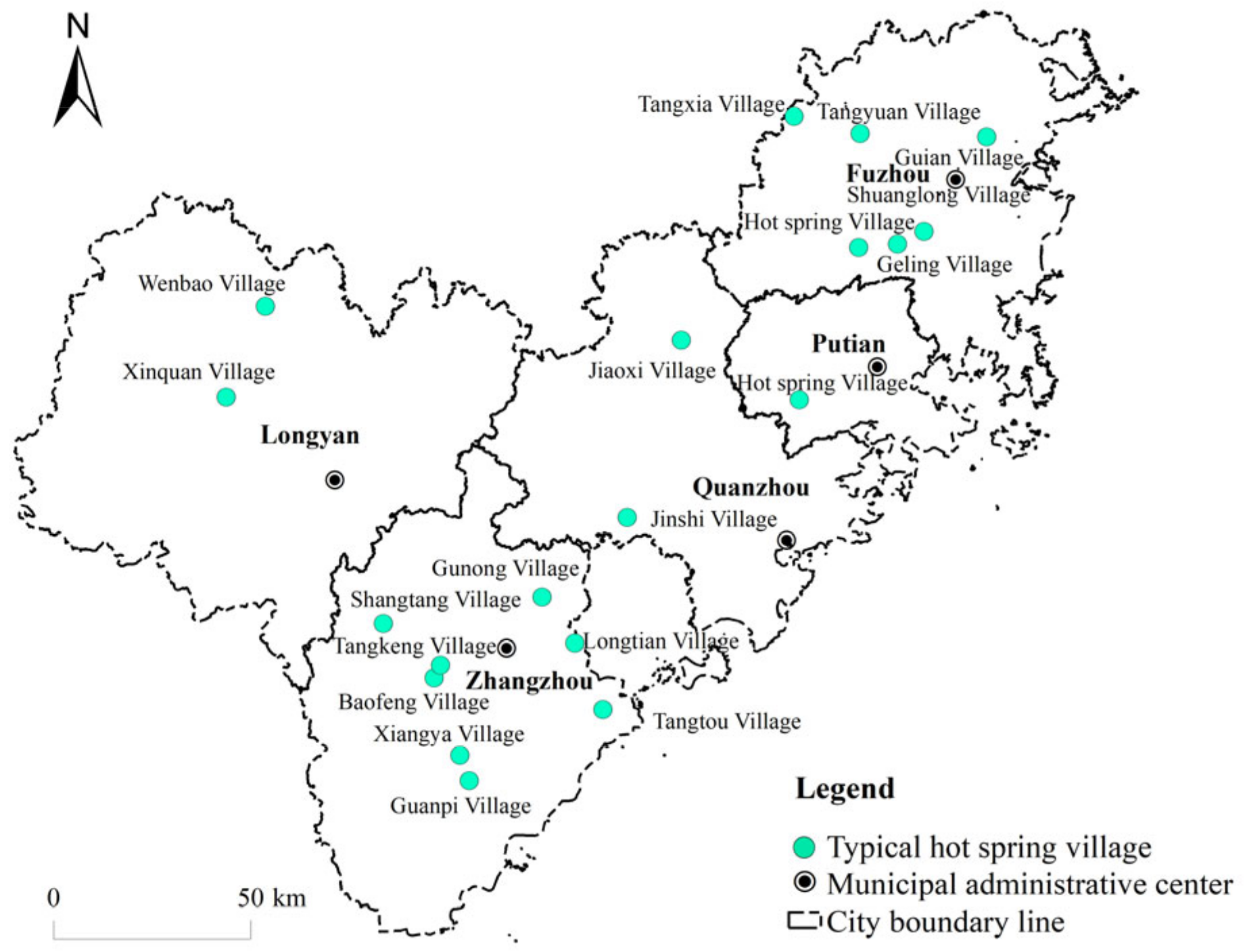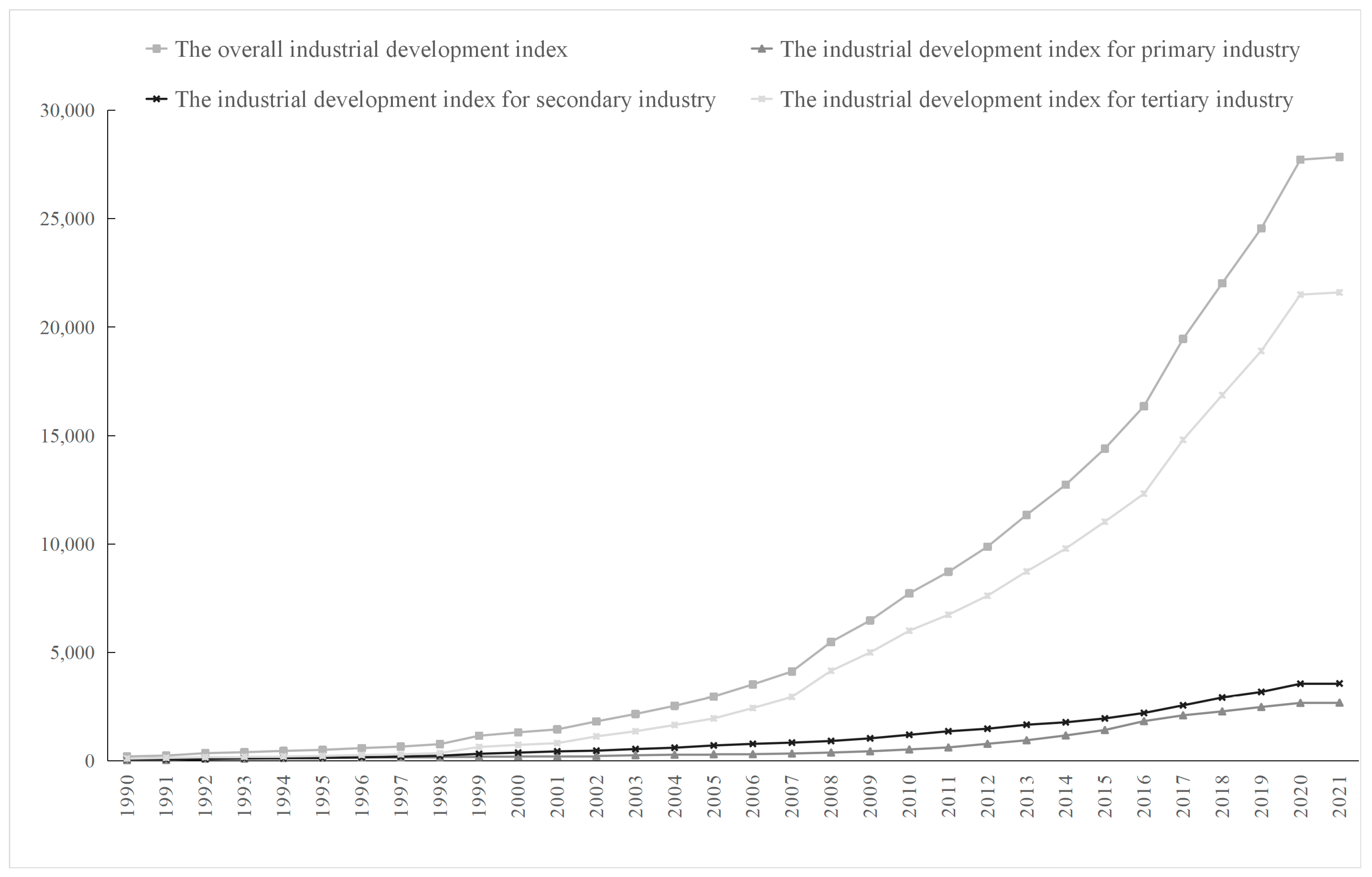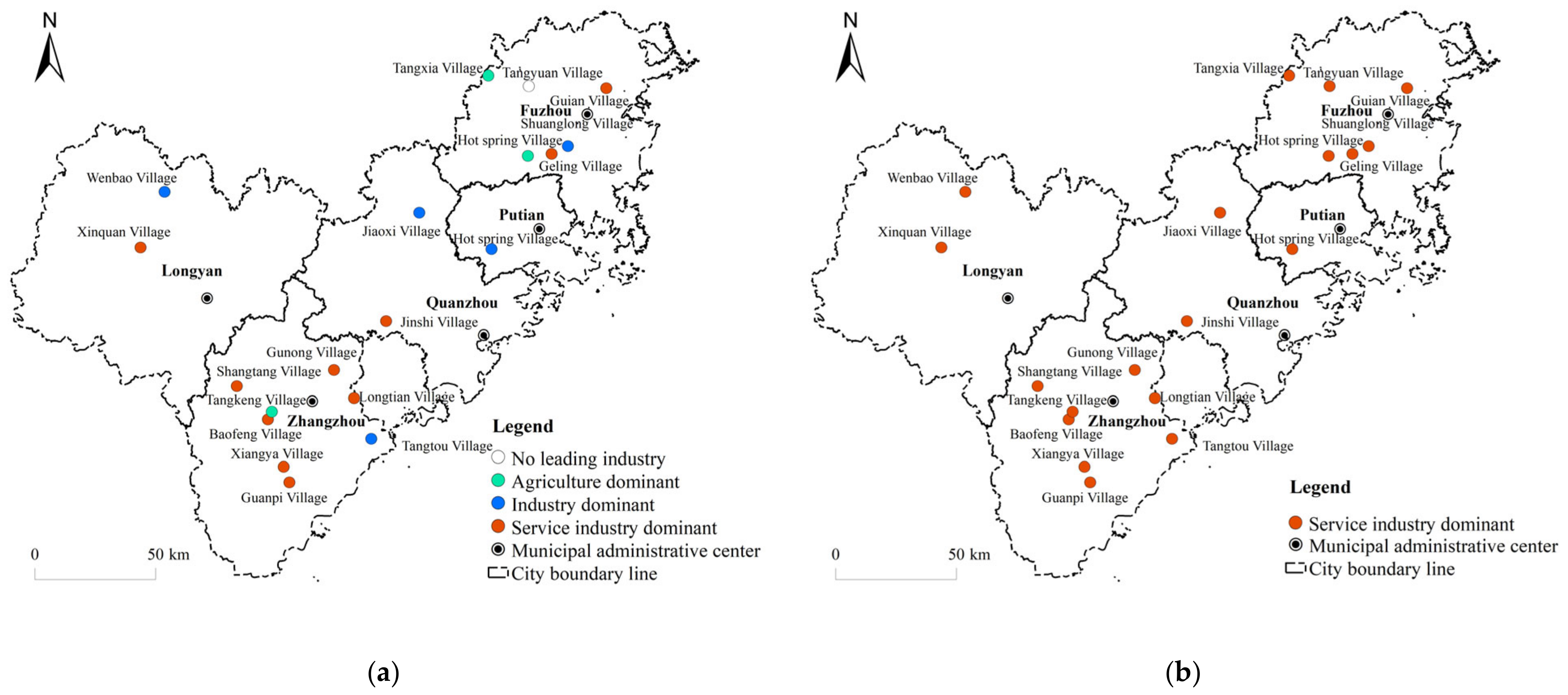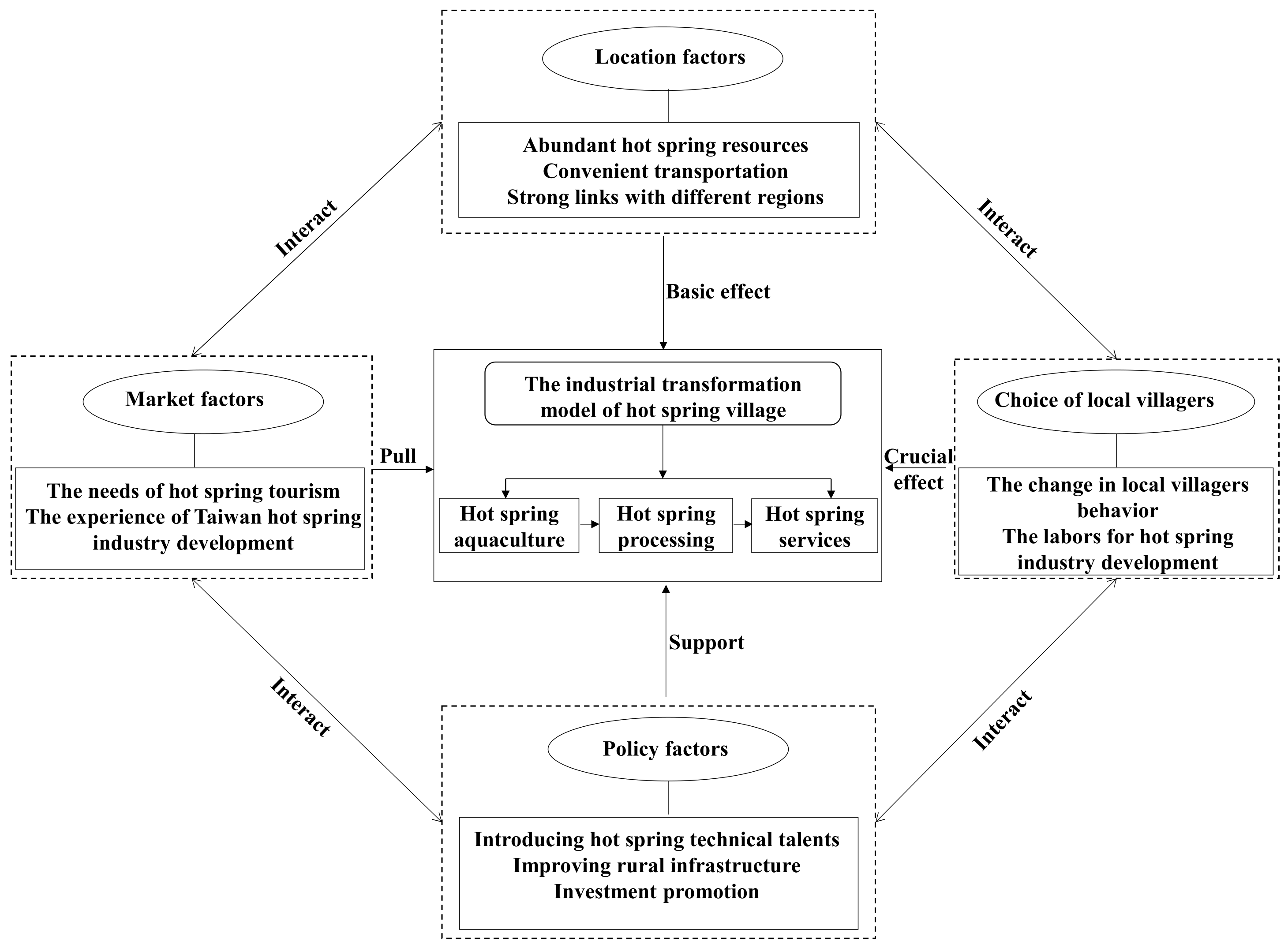Research on Industry Transformation Models and Influencing Factors of Hot Spring Villages from the Perspective of Sustainable Development: A Case Study of Fujian, China
Abstract
1. Introduction
2. Materials and Methods
2.1. Study Site
2.2. Construction of Industrial Development Index
2.2.1. The Evaluation Index Indicators
2.2.2. Standardization of Evaluation Indicators
2.3. Research Methods
2.3.1. Data Analysis
2.3.2. GIS Spatial Analysis
2.3.3. Field Investigation
2.4. Data Sources
3. Results
3.1. Characteristics of Industrial Transformation in Hot Spring Villages
3.1.1. Characteristics of Enterprise Types
3.1.2. Characteristics of Industrial Development Index Evolution
3.1.3. Spatial Characteristics of Industrial Development Index
3.1.4. Characteristics of Industrial Transformation Stage
3.2. Industrial Transformation Models of Hot Spring Villages
3.2.1. Hot Spring Aquaculture
3.2.2. Hot Spring Processing
3.2.3. Hot Spring Services
3.3. Influencing Factors of the Industrial Transformation Model of Hot Spring Villages
3.3.1. Location Factors
3.3.2. Market Factors
3.3.3. Choices of Local Villagers
3.3.4. Policy Factors
4. Conclusions and Discussions
5. Limitations and Future Directions
Author Contributions
Funding
Institutional Review Board Statement
Informed Consent Statement
Data Availability Statement
Acknowledgments
Conflicts of Interest
References
- James, C.K.; Cohen, M. Indulgence or therapy? Exploring the characteristics, motivations and experiences of hot springs bathers in Victoria, Australia. Asia Pac. J. Tour. Res. 2017, 22, 501–511. [Google Scholar]
- Choi, M.J. A research on the architectural characteristics of hot spring: Concentrated on the rural areas. J. Agric. Ext. Community Dev. 2011, 18, 281–313. [Google Scholar]
- Azhar-Hewitt, F. All paths lead to the hot spring: Conviviality, the code of honor, and capitalism in a Karakorum village, Pakistan. Mt. Res. Dev. 1998, 18, 265–272. [Google Scholar] [CrossRef]
- Morita, K. The Historical Transition and the Present Situation for the Enlivenment of Japanese Hot Spring Villages. Northeast Asia Tour. Res. 2013, 9, 293–309. [Google Scholar]
- Hao, W.P.; Wang, X.J.; Xiang, Y.H.; Gu-Li, A.M.; Li, M.; Zhang, X. History of hot spring bath treatment in China. Chin. J. Med. Hist. 2011, 41, 235–239. [Google Scholar]
- Medai, N.; Okamoto, N.; Ogasawara, Y.; Hihara, K. Factors contributing to tourism demand at major Japanese hot springs. PLoS ONE 2022, 17, e0274681. [Google Scholar] [CrossRef]
- Lei, M.; Ye, Q.L. The development of rural tourism in China: Inspiration of Japanese Hot Spring tourism. Econ. Manag. 2008, 10, 334–354. [Google Scholar]
- Wang, W.C.; Lin, C.H. A Model for Sustainable Tourism Development of Hot Spring Destinations Following Poverty Alleviation: Understanding the Tourists’ Perspective. Sustainability 2021, 13, 9856. [Google Scholar] [CrossRef]
- Hou, G.L.; Huang, Z.F. Tourists’ behavioral characteristics of Nanjing Tangshan hot spring resort and it’s tourism product optimization strategies. Geo. Res. Manag. Sustain. Dev. 2010, 1, 143–146. [Google Scholar]
- Wu, X.L. An Analysis Based on the KANO Model of Market Satisfaction about Hot Spring Leisure Tourism Product in Hainan. In Proceedings of the 2nd International Conference on Environmental Pollution and Public Health (EPPH 2016), Beijing, China, 10–12 April 2016; Volume 8, pp. 92–97. [Google Scholar]
- Ryu, E.J. Hot Spring tourism planning of Asan city and its characteristics: Using historical and cultural resources in the tourism development of Onyang hot spring. Northeast. Asia Tour. Res. 2016, 12, 143–164. [Google Scholar]
- Yu, T. Study on the sustainable development of the hot spring tourism in Heyuan City. In Proceedings of the 2015 International Forum on Energy, Environment Science and Materials (IFEESM), Shenzhen, China, 25–26 September 2015; Volume 40, pp. 1166–1170. [Google Scholar]
- Wu, X.L. Research on the Development and Innovation of Heyuan Hot Spring Tourism Resources under the View of “Hot Spring+”. In Proceedings of the IOP Conference Series: Earth and Environmental Science, Banda Aceh, Indonesia, 26–27 September 2018; Volume 199, pp. 22–25. [Google Scholar]
- Nipon, C. The potential of hot spring in the west of Thailand for health tourism and sustainability. Econ. World 2016, 4, 147–156. [Google Scholar]
- McGee, T.G. Managing the rural-urban transformation in East Asia in the 21st century. Sustain. Sci. 2008, 3, 155–167. [Google Scholar] [CrossRef]
- Long, H.L.; Tu, S.S. Rural restructuring: Theory, approach and research prospect. Acta Geogr. Sin. 2017, 72, 563–576. [Google Scholar]
- Chen, A.; Scott, S. Rural development strategies and government roles in the development of farmers’ cooperatives in China. J. Agric. Food Syst. Community Dev. 2014, 4, 35–55. [Google Scholar] [CrossRef]
- Liu, Y.S.; Li, Y.H. Revitalize the world’s countryside. Nature 2017, 548, 275–277. [Google Scholar] [CrossRef] [PubMed]
- John, H. Impulses towards a multifunctional transition in rural Australia: Interpreting regional dynamics in landscapes, lifestyles and livelihoods. Landsc. Res. 2008, 33, 211–223. [Google Scholar]
- Long, H.L. Land use transition and rural transformation development. Prog. Geogr. 2012, 31, 131–138. [Google Scholar]
- He, S.Y.; Fang, X.; Yang, G.Q. Can Comprehensive Land Consolidation Promote the Transformation of Rural Industries? Evidence from Some Villages in Hubei Province China. Land Sci. 2022, 36, 107–117. [Google Scholar]
- Sun, Y.P.; Zhou, Z.F.; Huang, D.H.; Chen, Q.; Fang, M. The Spatial and Temporal Evolution Pattern and Transformation of Urban-Rural Construction Land in Karst Mountainous Areas: Qixingguan District of Guizhou, Southwest China. Land 2022, 11, 1734. [Google Scholar] [CrossRef]
- Peng, S.G.; Wang, J.; Sun, H.; Guo, Z.N. How Does the Spatial Misallocation of Land Resources Affect Urban Industrial Transformation and Upgrading? Evidence from China. Land 2022, 11, 1630. [Google Scholar] [CrossRef]
- Ge, D.Z.; Long, H.L. Rural spatial governance and urban-rural integration development. Acta Geogr. Sin. 2020, 75, 1272–1286. [Google Scholar]
- Tian, J.; Zeng, S.P. Systematic Risk Assessment and Resilient Pattern Reconstruction of Rural Industry in Urban Fringe Areas. City Plan. Rev. 2021, 45, 19–30+58. [Google Scholar]
- He, Z.W.; Chen, T.M. Rural revitalization and “capable people” returning village: Research on the innovative diffusion mechanism of the concept of rural industrial transformation. J. Southwest Minzu Univ. (Humanit. Soc. Sci.) 2022, 43, 136–143. [Google Scholar]
- Wang, S.Q.; Li, Y.J. The Internal Logic and Path Selection of Agricultural Industry Transformation Under the Leadership of Rural Talents. Agric. Econ. 2021, 12, 13–14. [Google Scholar]
- Li, W.Y. Research on the coordinated development of hot spring tourism economy and suburban real estate. J. Commer. Econ. 2014, 24, 132–133. [Google Scholar]
- Li, P.; Feng, D. The politics of place naming: Changing place name and reproduction of meaning for Conghua hot spring. Hum. Geogr. 2015, 30, 58–64. [Google Scholar]
- Sung, K.P.; Park, K.W. A Review on the Historical Change of Hot Springs in Onyang-Oncheon. Northeast. Asia Tour. Res. 2011, 6, 83–103. [Google Scholar]
- Wang, G.X.; Bao, J.G. The character and spatial competition of thermal spring tourist resort: A case study of the thermal springs in Conghua City. Areal Res. Dev. 2004, 23, 83–87, 122. [Google Scholar]
- Liu, X.N. The path of the development of hot spring tourism in China. J. Hunan Univ. Sci. Technol. (Soc. Sci. Ed.) 2019, 22, 179–184. [Google Scholar]
- Shohei, K.; Yasuo, O. Competitive structure of accommodations in a traditional Japanese hot springs tourism area. Sustainability 2020, 12, 3062. [Google Scholar]
- Lee, T.-H. Assessing Visitors’ Experiences at Hot Spring Recreation Areas in Taiwan. Int. J. Tour. Res 2010, 12, 193–203. [Google Scholar] [CrossRef]
- Liu, Q.H. Theme positioning analysis and development enlightenment of leisure tourism real estate: Taking Jiangxi Tianmu Mingyue Mountain hot spring resort as an example. Enterp. Econ 2011, 30, 139–142. [Google Scholar]
- Lin, D.; Zheng, Y.X. Research on hot spring tourism development pattern of Fujian countryside: A case in Minhou Guangming hot spring. Resour. Dev. Mark 2011, 27, 938–940. [Google Scholar]
- Li, P. The rise and fall of hot-spring resort within the context of social reconstruction: A case study of Conghua hot-spring resorts. Trop. Geogr. 2010, 30, 540–545. [Google Scholar]
- Fei, G.Y. Research on the causes of the rise and fall of hot spring resorts and its restructure: A Case Study of Xifeng hot spring resort. J. Guangxi Norm. Univ. (Philos. Soc. Sci. Ed.) 2011, 47, 94–97. [Google Scholar]
- He, X.Q.; Gong, S.S. Tourism landscape of hot springs in Ancient China and its modern implications. Trop. Geogr. 2013, 33, 766–771. [Google Scholar]
- Lin, M.S.; Li, W.; Chen, Y.P.; Yu, H.; Qiu, J.L. Does the development of rural hot spring resources promote “neighborhood common prosperity”? J. Chin. Ecotourism 2023, 13, 222–236. [Google Scholar]
- Lin, M.S.; Jian, J.S.; Yu, H.; Zeng, Y.F.; Lin, M.L. Research on the Spatial Pattern and Influence Mechanism of Industrial Transformation and Development of Traditional Villages. Sustainability 2021, 13, 8898. [Google Scholar] [CrossRef]
- Wang, K.Y.; Huang, Y.W.; Wang, X.Z.; Wu, S.D. The spatial path evolution of Taiwanese enterprises “Westward Advancement” from the perspective of rural industry revitalization: A case study of Fujian Province. Geogr. Res. 2020, 39, 1104–1115. [Google Scholar]
- Lin, M.S.; Lin, J.H.; Cheng, Y.; Wang, X.G.; Zhang, M.F.; Qi, X.H. Ecological vulnerability assessment of key villages of tourism poverty alleviation in Fujian Province. Acta Ecol. Sin. 2018, 38, 7093–7101. [Google Scholar]
- Lin, M.S.; Lin, J.; LIN, C.B.; Zhang, A.; Wang, K.Y. Spatial diffusion of Taiwan enterprises in Mainland China under the vision of rural industrial vitalization. Sustainability 2018, 10, 3672–3690. [Google Scholar] [CrossRef]
- Ma, X.Y.; Shao, J.A.; Xu, X.L. Rural transportation accessibility in mountainous areas based on the entropy-weight TOPSIS method: A case study of Shizhu County, Chongqing Municipality. Prog. Geogr. 2016, 35, 1144–1154. [Google Scholar]
- Lin, M.S.; Yan, Y.; Zeng, C.S.; Zhu, H.; Wang, F.Y. The integration and development of red tourism resources in the Central Soviet Area from the perspective of cultural ecology. J. Nat. Resour. 2021, 36, 1734–1748. [Google Scholar]
- Aysan, A.; Kayani, F.; Kayani, U.N. The Chinese inward FDI and economic prospects amid COVID-19 crisis. Pak. J. Commer. Soc. Sci. 2020, 14, 1088–1105. [Google Scholar]
- Khan, M.; Kayani, U.N.; Khan, M.; Mughal, K.S.; Haseeb, M. COVID-19 Pandemic & Financial Market Volatility; Evidence from GARCH Models. J. Risk Financ. Manag. 2023, 16, 50. [Google Scholar]





| Indicator | Description | Attribute |
|---|---|---|
| Establishment date | The date approved by the government when the enterprise was established for the first time, reflecting the process of industrial transformation and development | + |
| Registration status | Including existing, in operation, revocation, cancellation, move in, move out, closure and liquidation, reflecting the state of industrial transformation and development | − |
| Enterprise type | Including individual ownership, joint ventures, and sole proprietorship, reflecting the models of industrial transformation and development | − |
| Number of enterprises | Including all rural enterprises, reflecting the scale of industrial transformation and development | + |
| Registered capital | The total amount of capital registered in the registration management agency for establishing a corporate enterprise, reflecting the strength of industrial transformation and development | + |
| Indicator | Standardized Value Assignment | ||||
|---|---|---|---|---|---|
| 2 | 4 | 6 | 8 | 10 | |
| Establishment time | 2017–2022 | 2012–2016 | 2006–2011 | 1988–2005 | 1966–1999 |
| Registration status | moving out | − | revocation, cancellation | − | existing, in operation |
| Enterprise type | individual ownership | − | sole proprietorship | − | joint ventures |
| Number of enterprises | ≤64 | 65–227 | 228–361 | 362–732 | >732 |
| Registered capital (RMB 10,000) | ≤2650 | 2651–16,000 | 16,001–49,800 | 49,801–115,800 | >115,800 |
| Typical Hot Spring Villages | Individual Ownership Enterprises | Sole Proprietorship Enterprises | Joint Venture Enterprises and Cooperatives | |||
|---|---|---|---|---|---|---|
| Number | Registered Capital (RMB 10,000) | Number | Registered Capital (RMB 10,000) | Number | Registered Capital (RMB 10,000) | |
| Geling Village in Yontai County | 331 | 990 | 88 | 197,456.3 | 93 | 485,359 |
| Guian Village in Lianjiang County | 379 | 134,198.2 | 79 | 614,354.05 | 110 | 191,396 |
| Shuanglong Village in Minhou County | 161 | 11,410 | 11 | 12,612 | 55 | 59,915 |
| Tangxia Village in Minqin County | 8 | 1773 | 6 | 40,339 | 12 | 100,042 |
| Tangyuan Village in MinhouCounty | 44 | 970 | 8 | 1726 | 9 | 3306 |
| Hot spring Village inYongtai County | 122 | 2665 | 25 | 69,060 | 15 | 12,890 |
| WenbaoVillage inLiancheng County | 143 | 14,512 | 22 | 11,899 | 31 | 11,405 |
| Xinquan Village in Liancheng County | 1060 | 18,716.5 | 28 | 3722.15 | 78 | 10,647.85 |
| Hot Spring Village in Xianyou County | 344 | 12,500 | 41 | 4624 | 43 | 9651.5 |
| Jiaoxi Village in Dehua County | 118 | 4725.5 | 14 | 6542 | 46 | 16,144 |
| Jinshi Village in An’xi County | 172 | 1101 | 28 | 3636 | 18 | 4742 |
| Baofeng Village in Heping County | 254 | 17,366.84 | 35 | 6288 | 72 | 14,896.1 |
| GunongVillage in Changtai County | 187 | 5566 | 31 | 32,216 | 46 | 7536.5 |
| Guanpi Village in Zhangpu County | 367 | 9665 | 46 | 2466 | 19 | 3851 |
| Longtian Village in Longhai County | 249 | 37,856.13 | 23 | 4502.37 | 45 | 30,860 |
| Shangtang Village in Nanjing County | 45 | 1598 | 4 | 1006 | 15 | 7774.6 |
| Tangkeng Village in Nanjing County | 349 | 18,510 | 41 | 11,049 | 57 | 10,863.93 |
| Tangtou Village in Longhai County | 591 | 36,658 | 49 | 6400.36 | 92 | 36,234 |
| Xiangya Village in Zhangpu County | 188 | 16,230.36 | 48 | 9000 | 39 | 7032.57 |
| Total | 5112 | 347,011.53 | 627 | 1,038,898.23 | 895 | 1,024,547.05 |
| Evolution Stage | Registered Time (Year) | Time for Scale Development (Year) | Number of Enterprises |
|---|---|---|---|
| aquatic product aquaculture | 1990 | 1999 | 227 |
| aquatic product retail | 1995 | 2006 | 120 |
| aquatic product wholesale | 1996 | 2010 | 23 |
| aquaculture technology promotion and information services | 2008 | 2015 | 47 |
| Evolution Stage | Registered Time (Year) | Time for Scale Development (Year) | Number of Enterprises |
|---|---|---|---|
| comprehensive development of hot spring agriculture | 1999 | 2015 | 9 |
| the exploitation and utilization of hot spring geothermal resources | 2001 | 2010 | 7 |
| Evolution Stage | First Appeared Time (Year) | Model Appeared Time (Year) | Number of Enterprises |
|---|---|---|---|
| Hot spring bathing | 1993 | 2005 | 218 |
| Hot spring resort | 2000 | 2010 | 41 |
| Hot spring tourism real estate | 2000 | 2015 | 16 |
Disclaimer/Publisher’s Note: The statements, opinions and data contained in all publications are solely those of the individual author(s) and contributor(s) and not of MDPI and/or the editor(s). MDPI and/or the editor(s) disclaim responsibility for any injury to people or property resulting from any ideas, methods, instructions or products referred to in the content. |
© 2023 by the authors. Licensee MDPI, Basel, Switzerland. This article is an open access article distributed under the terms and conditions of the Creative Commons Attribution (CC BY) license (https://creativecommons.org/licenses/by/4.0/).
Share and Cite
Liu, L.; Chen, Y.; Li, W.; Zeng, Y.; Lin, M. Research on Industry Transformation Models and Influencing Factors of Hot Spring Villages from the Perspective of Sustainable Development: A Case Study of Fujian, China. Sustainability 2023, 15, 9872. https://doi.org/10.3390/su15139872
Liu L, Chen Y, Li W, Zeng Y, Lin M. Research on Industry Transformation Models and Influencing Factors of Hot Spring Villages from the Perspective of Sustainable Development: A Case Study of Fujian, China. Sustainability. 2023; 15(13):9872. https://doi.org/10.3390/su15139872
Chicago/Turabian StyleLiu, Lihua, Yuping Chen, Wei Li, Yanfang Zeng, and Mingshui Lin. 2023. "Research on Industry Transformation Models and Influencing Factors of Hot Spring Villages from the Perspective of Sustainable Development: A Case Study of Fujian, China" Sustainability 15, no. 13: 9872. https://doi.org/10.3390/su15139872
APA StyleLiu, L., Chen, Y., Li, W., Zeng, Y., & Lin, M. (2023). Research on Industry Transformation Models and Influencing Factors of Hot Spring Villages from the Perspective of Sustainable Development: A Case Study of Fujian, China. Sustainability, 15(13), 9872. https://doi.org/10.3390/su15139872





